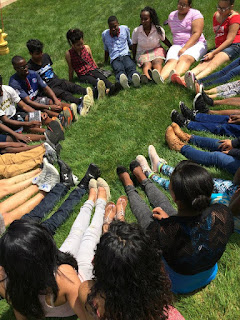Yesterday, in a Google Alert, I received news that Pew Research Center updated data on African immigration population in the U.S. as it continues to climb. Pew Research Center is a nonpartisan fact tank that informs the public about the issues, attitudes and trends shaping America and the world. They conduct public opinion polling, demographic research, content analysis and other data-driven social science research. They do not take policy positions, but release information so researchers like me can have further context in regard to changing demographics in our schools (among other reports).
In 2012, I wrote in A "Responsibility to Speak Out": Perspectives on Writing from Black African Born Male Youth with Limited or Disrupted Formal Education" that numerous factors resulted in the arrival of African refugee youth entering our urban schools.
I haven't read through all the data reported by Pew, but I thought this Wednesday would be a good day to revisit my thinking and work of supporting refugee youth in K-12 schools. The PEW Report is a welcomed update of what I need to know.
I will read it with respect and admiration of the numerous young people I've been fortunate to work with over the last twenty years.
In 2012, I wrote in A "Responsibility to Speak Out": Perspectives on Writing from Black African Born Male Youth with Limited or Disrupted Formal Education" that numerous factors resulted in the arrival of African refugee youth entering our urban schools.
Unlike the large numbers of immigrants who arrived in the late 19th and early 20th century, immigrants of the 21st century are relocating from nations undergoing civil unrest and where youth have had limited educational experiences. Nations that were once colonized by Europe began to experience civil conflict in the late 20th and early 21st centuries and have seen tremendous numbers of refugee populations. The U.S., once a colony itself, has played a central role in the political affairs of many of these nations since World War II. American provision and retraction of financial support has added to their national conflicts. Throughout Africa, as evident through recent revolutions in Egypt and Libya, yesterday’s colonial history has become part of today’s reality. With a strong international role in the world, the U.S. cannot shrug off its obligations.The 2015 PEW report indicates that the rise of such populations has continued since the time I conducted my initial research. The numbers of African immigrants, in fact, have doubled almost every year since 1970, resulting in a 41% increase of African populations entering the United States, often bringing school-aged children to American classrooms. In terms of refugee relocation, the United States accepts the largest number worldwide under its mission and dedication to freedom and democracy, but even so it is only 1% of the entire group of individuals and families who have fled their homes due to political turmoil, war, and fear of prosecution. At the time of my research (2012), I also wrote,
Currently, almost half of the world’s refugee and displaced populations reside within Africa, and it is likely that these numbers will increase. Civil uprisings like those recently occurring in Egypt and Libya, ongoing conflicts in nations like Sudan and Somalia, and drought within many western African nations will most likely continue toThis trend, PEW reports, has continued and the relocation is voluntary, unlike the involuntary movement of African lives during the age of the Atlantic Slave Trade which has been at the heart of America's most controversial, historical and damaging social movement in regards to racial relations. The arrival of new migrant populations has demonstrated success in terms of the American dream as reported by many national newspapers who have written the achievement of African immigrant populations in higher education has been astounding.
uproot large populations of people. As this occurs, more individuals will seek asylum,
even though only a very small percentage of those applying will be invited to relocate. According to Bixler (2005), the Congressional Black Caucus voiced their criticisms about the 1980 Refugee Act because only 1,500 of the 231,700 refugees who first relocated were from Africa. Their concerns about equity, and President Bill Clinton’s humanitarian interests in African nations, changed the demographics of who was given political asylum. As a result, the 1980 Refugee Act also widened the doors for individuals undergoing political turmoil in Africa, including Sudan, Liberia, and Somalia – the three nations of my participants. By 2004, half of all refugees arriving were from war-torn African nations. Consequently, Black refugee youth have begun to enroll in U.S. secondary schools most often in urban settings.
I haven't read through all the data reported by Pew, but I thought this Wednesday would be a good day to revisit my thinking and work of supporting refugee youth in K-12 schools. The PEW Report is a welcomed update of what I need to know.
I will read it with respect and admiration of the numerous young people I've been fortunate to work with over the last twenty years.


No comments:
Post a Comment